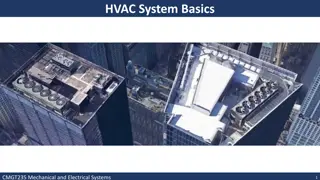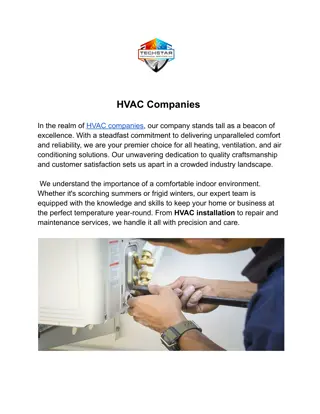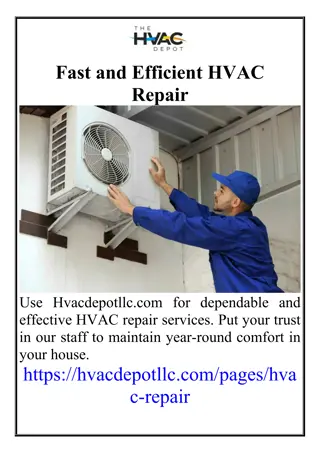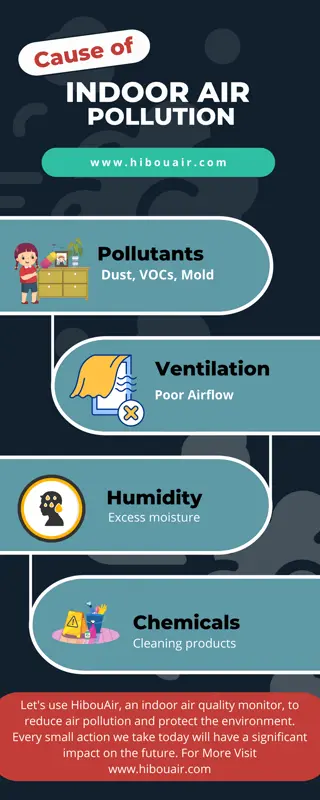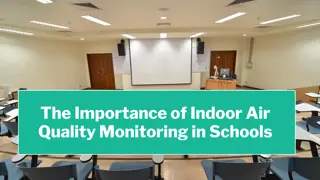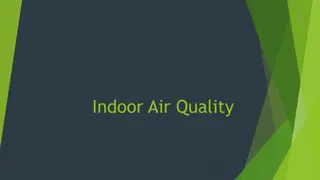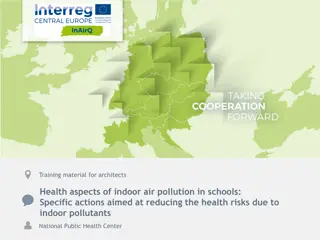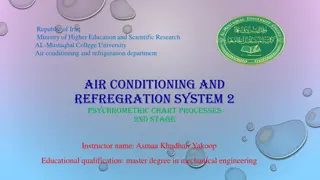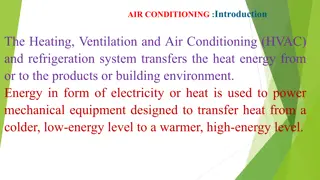Importance of Indoor Air Quality in HVAC Systems
Indoor air quality (IAQ) is crucial for HVAC systems as it directly impacts health, productivity, and overall well-being. Poor IAQ leads to health issues, decreased productivity, and higher absenteeism. The selection of HVAC equipment must prioritise energy efficiency, humidity control, and IAQ. The HVAC industry needs solutions for monitoring IAQ effectively to ensure a healthy indoor environment. Tenants are increasingly aware of IAQ issues, pushing HVAC professionals to address radon, VOCs, and other contaminants. Poor IAQ affects office workers' productivity, wellbeing, and health, resulting in significant financial losses for organizations. Educational buildings also face IAQ challenges impacting students' health and learning.
Download Presentation

Please find below an Image/Link to download the presentation.
The content on the website is provided AS IS for your information and personal use only. It may not be sold, licensed, or shared on other websites without obtaining consent from the author.If you encounter any issues during the download, it is possible that the publisher has removed the file from their server.
You are allowed to download the files provided on this website for personal or commercial use, subject to the condition that they are used lawfully. All files are the property of their respective owners.
The content on the website is provided AS IS for your information and personal use only. It may not be sold, licensed, or shared on other websites without obtaining consent from the author.
E N D
Presentation Transcript
1 HVAC Why does indoor air quality (IAQ) matter?
2 2 The selection of equipment for heating, cooling and ventilating is a complex design decision that must balance a great many factors, including energy efficiency, humidity control [and] indoor air quality. Heating, Ventilation and Air-Conditioning Systems (EPA)
3 3 What does this mean for the HVAC industry? We need solutions to measure and monitor indoor air quality, in a way that is: Simple to install Easy to operate Able to monitor different contaminants and factors Time and cost-saving for HVAC professionals Collects all data in one place for central monitoring and recommendations Compatible with existing building automation systems (BAS)
4 4 Some tenants are even installing their own IAQ monitors and keeping an eye on: What does all this mean for HVAC professionals? Radon VOCs Greater awareness More tenant complaints and work orders Greater risk of tenant turnover Companies increasingly responding to employee demand for better working environments, especially among the younger generation Buildings that don t offer satisfactory facilities will struggle to stay successful Carbon dioxide (CO2) Humidity Temperature Pressure
5 Bad IAQ = bad news for tenants 70% of office workers believe poor IAQ is affecting their productivity and wellbeing 1in3 office workers believe poor IAQ is impacting their health Organizations in the US alone are losing $168 billion every year because of poor IAQ People experience more illness and take more time off due to Sick Building Syndrome
6 And it s the same story in educational buildings... 91% of parents believe the quality of air students breathe impacts their health 80% 13.8 Test scores are worse in rooms with poor indoor air quality of parents believe the quality of air students breathe impacts their learning million school days (2.6 per student) per year are missed in the US due to asthma
7 What causes poor indoor air quality? And guess what? In industrialized nations, we spend Indoor air can be 5x More polluted than outdoor air 90% of our time indoors This growing public health issue is a hot topic for the World Health Organization, environmental regulators, and lawmakers.
8 1 8 What causes poor indoor air quality? Colorless Odorless Builds up in well- insulated industrial buildings 15,000 - 22,000 lung cancer deaths annually in the US No. 1 cause of lung cancer for non-smokers Emitted naturally by breathing Builds up through the day in poorly ventilated offices that recycle air Drowsiness Poor decision-making Low productivity Infectious disease transmission and sick leave CO2 Radon
9 1 9 What causes poor indoor air quality? Too dry Coughs and colds Infectious disease transmission Dry skin and hair Too humid Mold growth Asthma worsening Humidity Particles emitted from cleaning agents, air fresheners, floor and wall coverings, paints, furniture Include formaldehyde, toluene, ozone Boosted by heat from computers and electronics Headaches Eye, nose and throat swelling Impact on heart conditions, asthma, lung cancer, reproduction VOCs Excess heat Lower cognitive capacity Above average temp, every +1 F -1% performance Temperature
10 What happens when you monitor and improve indoor air quality? HVAC professionals save time and cost Using an easy-to-install wireless system makes setup a matter of minutes Track many different contaminants in multiple spaces and buildings, all from one central hub User-friendly modern monitors are remote-controlled and friendly Sensor data is collected and integrated with existing building automation systems (BAS)
11 The whole building gets more efficient Plan meeting spaces more efficiently by using CO2to track usage over time Reduce energy bill by monitoring occupancy and turning off unused: Heating Ventilation Air conditioning Lights Save time on the job by tracking all spaces from one central, digital hub Save on cleaning costs by matching schedules to occupancy and usage Boost cafeteria profitability and reduce waste by gaining an accurate picture of building occupancy and matching food production to footfall Make better-informed decisions based on data-driven insights
12 Workers and students perform better, making tenants more successful Spending just $40 per person ? $6500 increase in employee productivity 58% 61% 101% Less sick leave taken by workers better performance on cognitive tasks Improvement in decision- making scores
13 13 Buildings gain a key USP for attracting new customers and clients Best conditions for healthy, productive workers Better learning environments for students to learn and excel Optimal environment for organizations to thrive



